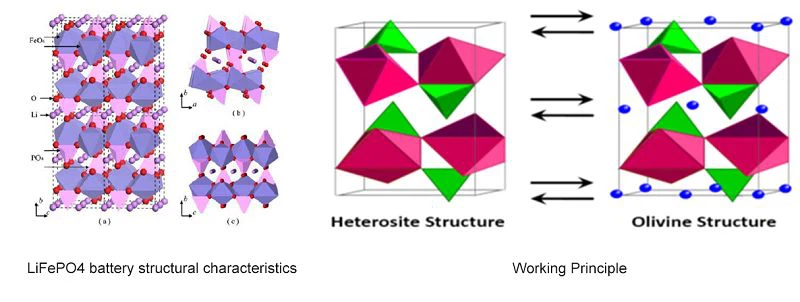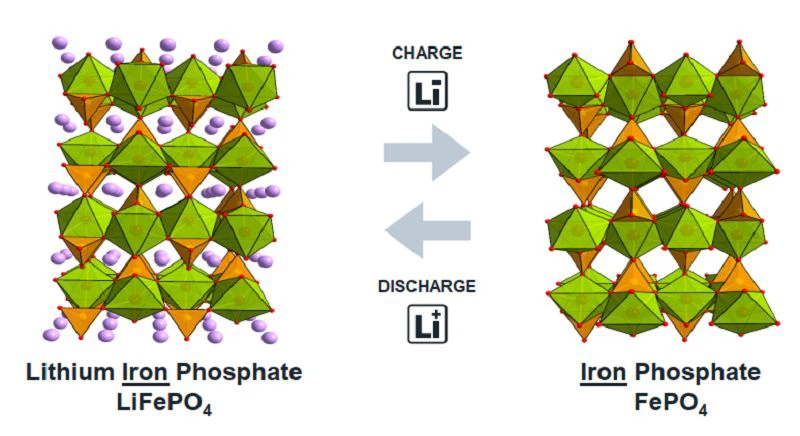I: Overview of Lithium Iron Phosphate Batteries (LiFePO4)
What is a lithium iron phosphate battery(LiFePO4)?
1). LiFePO4 battery uses lithium iron phosphate as a positive electrode material.
2). The rated voltage of a single LiFePO4 battery is 3.2V, and the charge cut-off voltage is 3.6V~3.65V.
3). LiFePO4 supports expansion and stores large-scale electric energy after forming an energy storage system.
4). The LiFePO4 battery energy storage system consists of a LiFePO4 battery pack, Battery Management System (BMS), rectifier, inverter, central monitoring system, transformer, etc.
As we all know, the market popularity continues to rise, which is determined by the characteristics of the LiFePO4 battery:
1. Good safety performance, long cycle life, no burning and no explosion when overcharged;
2. Good high-temperature performance, working temperature range 20°C ~70°C;
3. Long cycle life, ≥ 4000 times;
4. Fast charging, with 1C-5C fast charging capability, significantly
shortening the charging time;
5. High working voltage and high energy density
6. Green and environmental protection, no harmful substances, no pollution to the environment;
7. Significant economic benefits, renewable energy;
II. The structural characteristics of LiFePO4 battery:
1. Positive electrode: LiFePO4 with olivine structure, the positive electrode connects aluminum foil;
2. Negative electrode: composed of carbon or graphite; the negative electrode connects a copper foil.
3. Diaphragm: The diaphragm separates the battery from the positive electrode; the diaphragm material is a polymer;
4. Electrolytes: such as lithium hexafluorophosphate, lithium perchlorate, lithium tetrafluoroborate, etc.
5. Electrolyte: ethylene carbonate, propylene carbonate, dimethyl carbonate, ethyl butyrate, fluoroethylene carbonate, lithium bis-oxalate borate, lithium hexafluorophosphate.
6. Insulation materials, safety valves,
sealing rings, shells, etc.

III. The
charging and discharging principle of LiFePO4 battery
In short, during the charging process, the lithium ions Li+ in the LiFePO4 positive electrode migrate to the negative electrode through the polymer separator; during the discharge process, the lithium ions Li+ in the negative electrode migrate to the positive electrode again through the separator.
Charging principle: When the battery charges, lithium ions migrate from the LiFePO4 crystal to the crystal surface. Under the electric field force, Li+ enters the electrolyte, passes through the separator, then migrates to the surface of the graphite crystal through the electrolyte, and then intercalates into the graphite lattice. The electrons flow to the aluminum foil collector through the conductor. Pass through the tab, the positive pole, the external circuit, the negative pole, and the negative pole, flowing to the copper foil collector of the negative pole. Finally, it flows to the graphite negative electrode through the conductor to balance the charge of the negative electrode. After the lithium ions are deintercalated from the lithium iron phosphate, the lithium iron phosphate converts into iron phosphate.
Discharge
principle: When the battery discharge, lithium ions are deintercalated from the
graphite crystal, enter the electrolyte, and then pass through the separator,
migrate to the surface of the lithium iron phosphate crystal through the
electrolyte, and then re-insert into the lattice of lithium iron phosphate.
Electrons flow to the copper foil collector through the conductor. And flow to
the aluminum foil collector of the positive electrode through the tab, battery
negative pole, an external circuit, positive pole, and positive pole. Then flow
to the lithium iron phosphate positive pole through the conductor and the
positive charge is balanced. After the lithium ions intercalate into the iron
phosphate crystal, the iron phosphate converts into lithium iron phosphate.
Charging and
Discharging Principle
The charging
and discharging principle of LiFePO4 battery energy storage system: In the
charging stage, the intermittent power supply or the power grid charges the
energy storage system. The alternating current is rectified into direct current
through the rectifier to charge the energy storage battery module then store
energy. In the discharge stage, the energy storage system discharges to the
grid or load. The DC power convert into AC power through the inverter. And the
inverter output is controlled by the central monitoring system, which can
provide stable power output to the grid or load.

